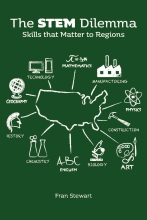
Graduates with degrees in science, technology, engineering, and mathematics (STEM) fields are in high demand, and the jobs they fill are high-paying. Indeed, many states offer financial incentives to try to grow the number of STEM grads and, by association, the economies of the regions they work in. But a new book from the Upjohn Press proposes that the link between STEM degrees and regional economic health is not as cut and dried as STEM proponents profess.
In The STEM Dilemma: Skills that Matter to Regions, Fran Stewart dives into the murky waters where education and economic goals meet to confront several key issues facing policymakers and educators, including the role of public investment in human capital, the types of human capital investment that provide the greatest public return, and whether those investments should vary by region. Her detailed findings provide evidence that not all high-paying jobs require STEM skills; that not all good-paying, highly skilled STEM jobs require college degrees, and that “soft skills” (e.g., critical thinking and communication) are important for STEM as well as other high-paying jobs.
Stewart draws on federal data sources to categorize occupations by their STEM and “soft” skill requirements. She examines how the two types of skills interact and determines how variation in human capital concentrations impacts regional economic wellbeing. Stewart also digs deeper into the complexity of human capital to examine the effects of “middle skills” on regional economic wellbeing.
As she points out, STEM graduates are important for the overall economy. Yet, not all regions are home to the types of industries that rely on workers with STEM skills. For example, there was a 5-fold difference between regions with the largest share of high-STEM employment and those with the smallest. Policy preoccupation with promoting STEM degrees may be overlooking other types of training that may yield greater economic benefit. This suggests that, by adopting one-size-fits-all strategies for human capital development, regions may be failing to reap the greatest possible returns on their public investments.
Stewart sums up her work in this book by saying:
Through a more fine-grained approach to operationalizing the concept of human capital than is found in discussions of STEM occupations, a new and more complete picture of how human capital impacts regional economic wellbeing emerges. Some of these new insights open new avenues for policy. This research exposes the thorny challenges associated with developing an economically viable workforce.
Stewart concludes with several key findings based on her empirical work that will be pertinent for anyone with an interest in workforce development and regional economic development. These include
Degrees matter more to individuals than to regional economies.
Occupations requiring “high” STEM skills do not necessarily require workers with college degrees.
Not all high-paying jobs require STEM skills.
Industries with higher STEM requirements tend to employ fewer workers.
Low-skill, low-wage jobs predominate in most regions.
Regional differences in the demand for STEM skills matter.
Regional human capital, while important, does not fully explain why some regions perform better than others.
